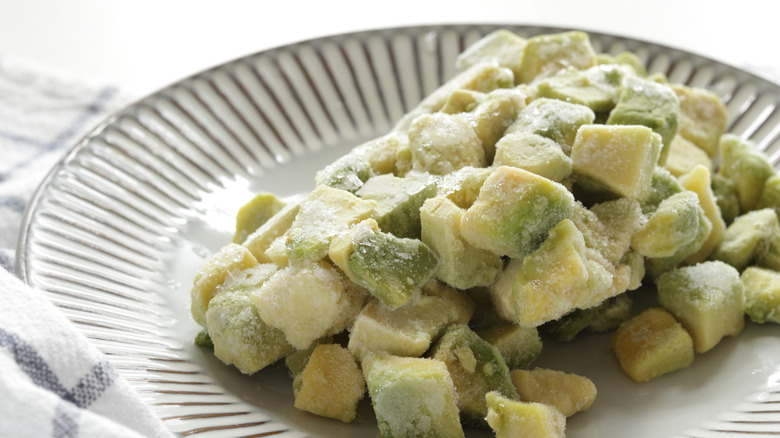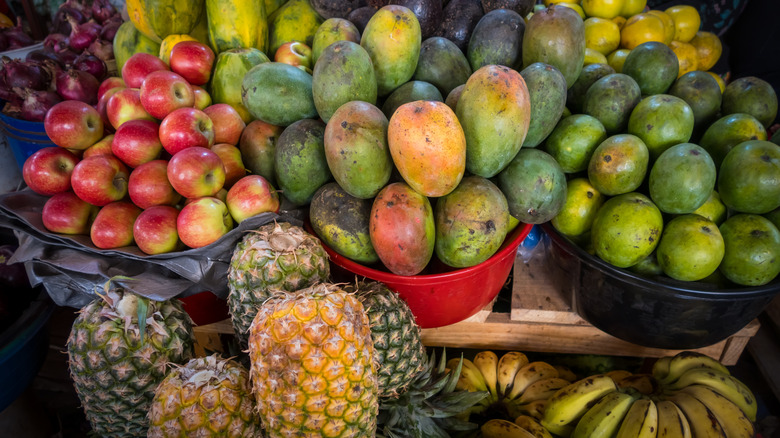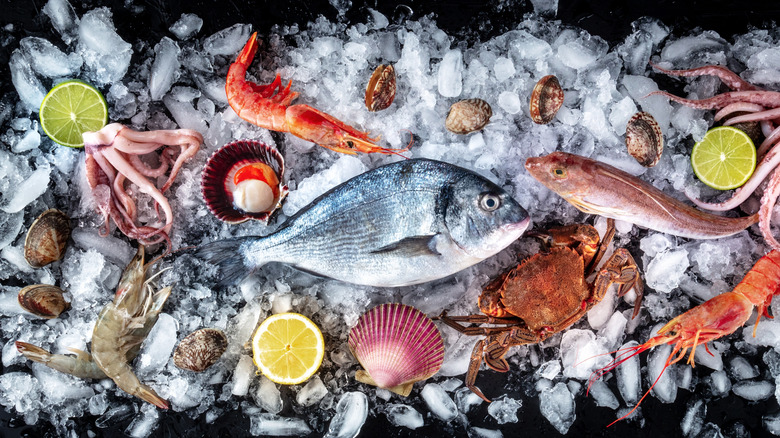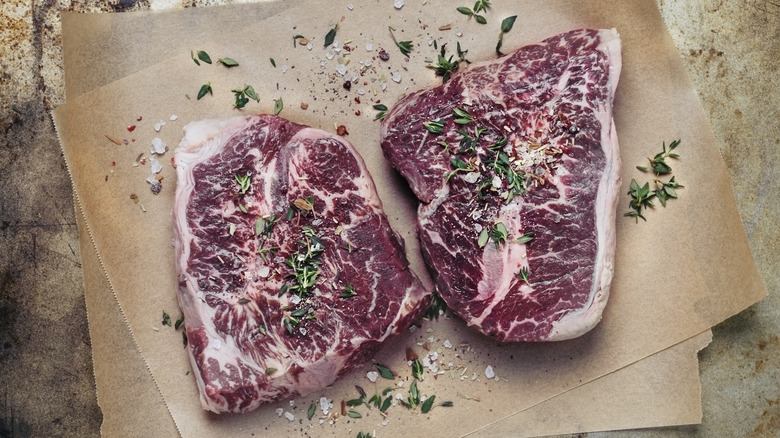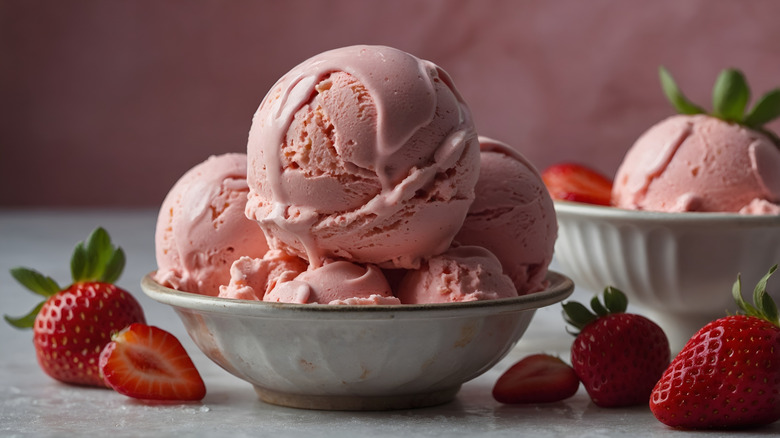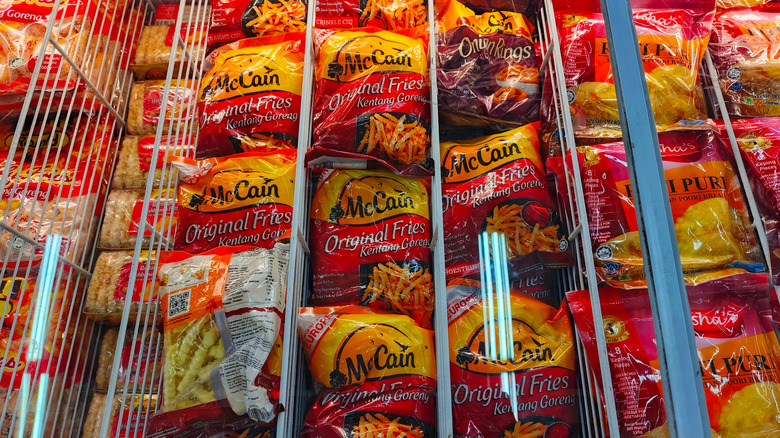Frozen Foods To Buy Before They Shoot Up In Price
Ideally, the federal government makes life easier for U.S. citizens — but in practice, it sometimes does not work that way. Inflation has been a problem for a long time — it occurs periodically, and the current tariff war will add to the problem. Grocery prices are likely to be affected to some extent, with the prices of some common food items increasing anyway. When importers pay higher tariffs, they typically pass them on to the food-buying public. It's frustrating for consumers. After all, you can't boycott groceries — you've got to feed your family. However, there are ways to help ease the pinch while still eating regular and healthy meals.
Frozen foods have a much longer shelf life than fresh, and are readily available in supermarkets and smaller local stores. Nothing beats fresh food, but many frozen items maintain their flavor and nutritional content and allow you to store them in larger quantities. For example, you might want to store honey in the freezer – and you can freeze many food items, even Trader Joe's pizza dough.
If you have a large chest freezer, a good strategy is to stock up on frozen food before the prices of certain items rise. This can help you feed your family without draining your bank account while waiting for prices to return to normal. Make sure you know when it's time to defrost your freezer, to keep food in the best condition — and check our list of frozen food items that are most likely to rise due to tariffs, so you can plan accordingly.
Avocados
Avocados have been a part of people's diets for thousands of years, however their popularity in the U.S. is more recent. During the late 1990s through the early 2000s, consumption of avocados grew significantly. This was due in part to the Avocados from Mexico advertising campaign and the greater awareness of the health benefits of the fruit — they're good for heart health, can aid digestion, and have numerous other benefits. Their creamy texture and subtle flavor also contribute to their popularity. Used in salads, to make guacamole, or on toast, the avocado is here to stay. But prices could soon increase.
Domestic production of avocados is largely based in California, but the number of avocados produced there has been declining since the early 2000s due to high production costs. Currently, the U.S. imports 90% of its avocados from Mexico. The country is more than up to the task of fulfilling the American demand for avocados, but is one of the prime targets in the tariff war, and price increases will certainly be felt as tariffs are imposed.
Although frozen avocados are not quite as good as fresh ones for some dishes, they do mean you don't have to worry about preventing avocados from browning. For those who can't live without the popular green fruit, stocking up on the frozen variety before the price increase could be wise — and frozen avocados work as well as fresh on toast, in guac, or in smoothies.
Berries
Blueberries, raspberries, blackberries, and strawberries are sweet, delicious fruits on their own or mixed together in various combinations. They can be thawed and eaten as they are, or used to make jams, dessert toppings, or in baked goods. Beyond the tastiness they provide, berries are also loaded with antioxidants, and contain fiber and nutrients such as Vitamin C, manganese, and Vitamin K1. But if you are a berry fan, you may want to load your freezer with a good supply of berry mixes, since they are also vulnerable to price increases.
The state of Washington is the largest producer of blueberries in the nation, so there is a domestic supply. However, some farms send blueberries to Canada for processing before they're returned — and Canada is another nation under the crosshairs of the tariff war. The processed fruit could then be subjected to tariffs crossing the border in both directions.
The U.S. also imports raspberries and strawberries from Mexico. With the heavy tariffs, the prices of these fruits could increase, significantly raising the price of frozen berry mixes. It's a good item to stock up on.
Tropical fruits
Tropical fruits like bananas, pineapples, mangoes, coconuts, and papayas are healthy foods packed with nutrients. Tropical fruits are among the best sources of flavonoids, and pineapple contains 88% of the recommended intake of Vitamin C. In addition to their nutritional content, bananas may aid digestion and maintenance of healthy blood sugar levels. Tropical fruits are available frozen, but nearly all tropical fruit sold in the U.S. is imported from South American and Asian nations – and prices are projected to see significant increases due to impending tariffs.
Frozen tropical fruits are very versatile — they can be used in many sweet and savory cooking applications, as well as making juices or refreshing cocktails like a fruity pina colada. They also make tasty treats all on their own. If you are one of the many fans of tropical fruit, do your taste buds and overall health a favor, and get a supply into your freezer before the prices increase.
Broccoli
Frozen vegetables are hugely convenient — they can be stored for long periods, are helpful in meal prep, and can save money. During these difficult economic times, that is more important than ever. Frozen broccoli in particular is enormously popular. California is the leading producer of domestic broccoli. However, U.S. broccoli production has decreased over recent years, and some broccoli is imported from Mexico and China, both major producers of the popular vegetable. Both of these nations are high on the tariff hit list, and this is likely to drive up frozen broccoli prices significantly. It's worth noting that frozen broccoli is also shipped to the U.S from Mexico, as well as the fresh variety.
Frozen broccoli can be cooked on its own or mixed into other dishes — you can even add it to pasta and soups from frozen without needing to thaw it first. It's also one of the healthiest vegetables – broccoli is loaded with Vitamin K, contains some protein, and is a good source of Vitamin C. Make room in the freezer — you're going to want to stock up.
Frozen fruit juice concentrate
You may wonder, whatever happened to frozen orange juice? It might not be as prominently displayed, but you can still find it, along with other types of fruit juice concentrate, in your supermarket's freezers. In addition to orange, apple, grapefruit, cranberry, and other fruit flavors are tasty beverages — and they can also be used to make cocktails or smoothies. Buying 100% real fruit juice concentrate means it's naturally sweetened and provides many of the nutritional benefits of fruit juice – citrus and apple juices are high in Vitamin C, for example, and along with cranberry juice, are rich with antioxidants. Frozen concentrate also comes in convenient cans that you can store in your freezer for whenever you need them. Unfortunately, however, they will likely be impacted by the tariff war, for a couple of reasons.
China is one of the world's leading exporters of apple juice concentrate, and also one of the primary targets of tariffs. Frozen apple juice prices are likely to rise accordingly, as could frozen orange juice concentrate from Brazil. Another indirect effect of tariffs is the higher price of aluminum imported from Canada. Many fruit juice concentrates come in cans with aluminum ends, and the higher cost of packaging could jack up the price, making frozen fruit juice concentrate another item to stock up on.
Fish and seafood
Seafood is a protein many people enjoy. Salmon, cod, shrimp, tuna, and oysters are among the most popular, but many kinds of seafood have great health benefits, such as improving heart health and providing protein and Vitamin D as well as essential Omega-3 fatty acids. Seafood tends to have a shorter shelf life than other meats, so buying it frozen is a good option. If you don't live near either coast, the seafood at your local supermarket was most likely shipped frozen anyway. But since it's included on our list, you've probably surmised that seafood is likely to get more expensive.
According to NOAA Fisheries, the U.S. imports up to 85% of its seafood. Fresh and frozen fish imported from Chile and Vietnam may see price increases. And a significant amount of seafood also comes from Brazil and China – areas scheduled to be hit with tariffs, which will, of course, cause prices to rise. Some seafood caught in the U.S. is also sent to China for processing before being returned frozen. So if you love fish, crustaceans, and bivalves, consider buying a frozen supply before any price increases happen – frozen shrimp, pangasius, and tilapia are especially likely to cost more.
Beef
Whether it's a great steak, a juicy burger, or a filling roast, people love beef. It's a great source of protein, iron, and zinc, and contains other important nutrients. Despite the trends over the years toward plant-based diets, Statista reports that in 2021, American consumption of beef reached a new high of 30 billion pounds — and red meat is likely to be a dietary staple in the U.S. for some time to come. The U.S. produces 90% of the beef consumed by its citizens, which would seem to make it free from the tariff-effect. Unfortunately, this is not so, as it's actually one of the foods likely to be affected by tariffs.
American beef cows tend to produce meat with a fairly high fat content. The fat is trimmed off and mixed with leaner beef imported primarily from Australia and New Zealand, then ground up and sold as ground beef. The price of ground beef – which makes up around half the beef eaten in the U.S. — is at an all-time high, and tariffs will likely drive prices even higher.
Per the USDA, the size of the cattle herd in the U.S. has decreased by 8% in recent years. Reduced supply will naturally further affect prices. Tariffs will also destabilize the beef market, affecting both imports and exports, which will also likely result in price increases. If you are a beef eater, consider filling your freezer before the price rises.
Chicken
Chicken is a popular and versatile form of meat that's is consumed by 75% of Americans at least once per week, according to Chicken Check In. Poultry is a good source of protein, although it has slightly less of the nutrient than beef — but it also has less saturated fat than red meat, too, and contains tryptophan, which can increase the production of serotonin. Whether it's fried, roasted, or baked, the meat can be cooked whole or in parts, making it extremely versatile for home cooks. Skinless, boneless, or in soups and stews, you could fill a menu with just chicken dishes — not to mention all the frozen forms available. But sadly, this extremely popular food item could also be impacted by tariffs.
China, a nation that will be hit with heavy tariffs, buys hundreds of millions of dollars worth of chicken per year, providing significant income for the U.S. poultry industry. The Chinese government plans to retaliate with high tariffs on U.S. goods, and chicken is one of them. This will likely diminish this lucrative source of revenue, putting financial stress on chicken producers. Prices in the U.S. could rise to compensate for the lost profits — and poultry prices are already higher than they were a year ago. So perhaps make some room between the seafood and the beef for some chicken in your freezer.
Ice cream
Nutrition is important, but the occasional tasty treat can also enhance our mood – and ice cream is a favorite. It's refreshing, especially when the weather is hot, and it comes in a wide variety of flavors — though you sometimes can't beat a good quality brand of vanilla ice cream, either. The International Dairy Foods Association reports that U.S. ice cream manufacturers produced 1.31 billion gallons of ice cream in 2024, and the average American consumes about 19 pounds of the sweet treat annually. In a bowl, a cone, on a stick, or in a sundae, we keep enjoying ice cream. But sadly, the popular treat will be indirectly impacted by tariffs.
Ingredients such as chocolate, vanilla bean, and cane sugar are imported by most ice cream producers, especially smaller operations that make handcrafted ice cream. This increases production costs, and prices rise accordingly. Another problem is that the U.S. exports ice cream to other countries, and Mexico and Canada are high on the list. Tariffs on these nations could reduce the amount of ice cream they purchase, and impact companies financially, forcing them to raise prices to compensate. You keep ice cream in the freezer anyway — but you may want to stock up.
Frozen french fries
When it comes to side dishes, french fries are one of the nation's favorites. They are the perfect pairing for burgers and hot dogs, and they also go well with a nice juicy steak. A crispy basket of fries is also a satisfying little meal on its own. Homemade french fries are delicious, but time-consuming to prepare: Peeling and cutting potatoes is quite a chore, and most people don't have a deep fryer. Unsurprisingly, according to the USDA, Americans are been choosing frozen potatoes over fresh with increasing frequency in recent years. The U.S. also produces its own potatoes, which would seem to make frozen french fries tariff-proof. Unfortunately, that is not the case.
Canada is the main exporter of frozen french fries to the U.S., sending 86% of the imports America buys. Our northern neighbor is being hit with some of the heaviest tariffs, and this will likely cause the price of frozen french fries to rise. Plus, much of the canola oil used for cooking them also comes from Canada. If you are one of the millions of french fry fans, this could be another item to stock up on.
Frozen fruit bars
Frozen fruit bars are a tasty snack that can cool you off in the summer heat. Americans certainly enjoy them: The National Frozen & Refrigerated Food Association reported that in 2019, nearly $691 million worth of fruit bars were sold in the U.S., and the global market continues to grow. That should not be surprising. Frozen fruit bars come in a variety of delicious flavors, and the brands labelled as being made with real fruit must contain at least 95% real fruit juices. These juices are loaded with nutrients and antioxidants, and the bars can be conveniently stored in your freezer — which is useful, because this is yet another item that could see price increases as a result of the tariff war.
As we have already seen, the U.S. imports a significant amount of fresh fruit from Mexico, and fresh fruit is necessary to make juice. The tariffs could increase production costs, and that will likely lead to higher prices on frozen fruit bars. So perhaps seek out a supply of frozen fruit bars before the cost rises.

